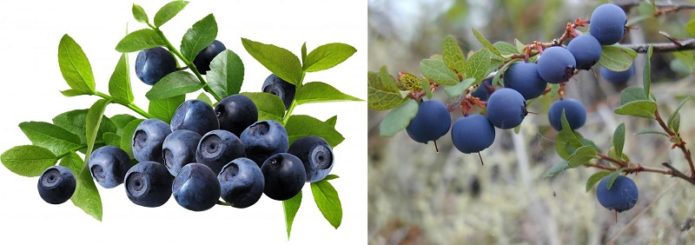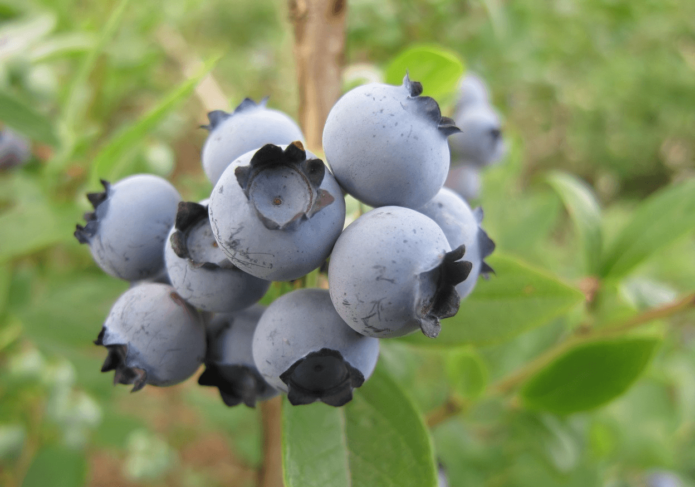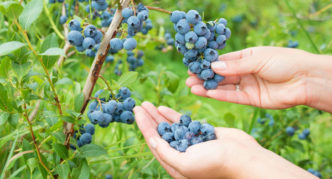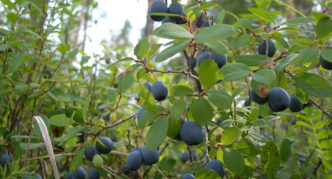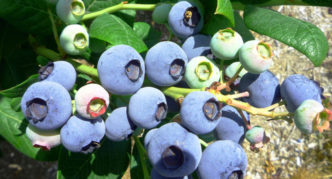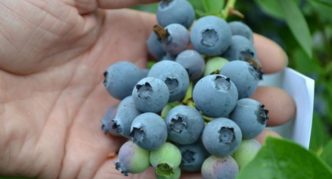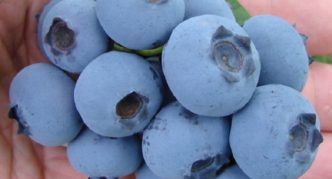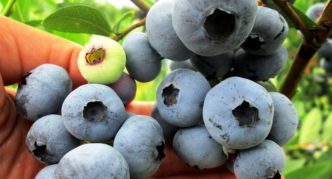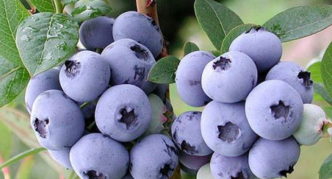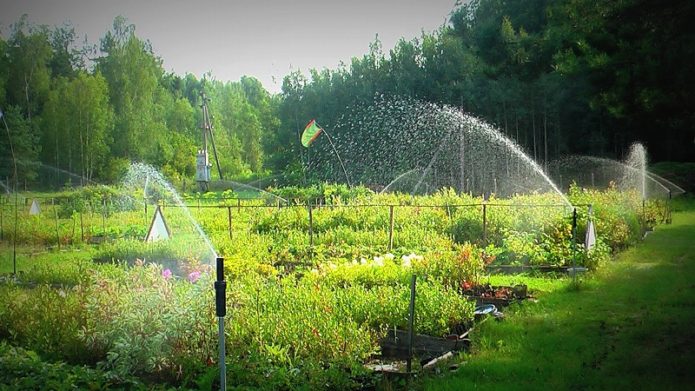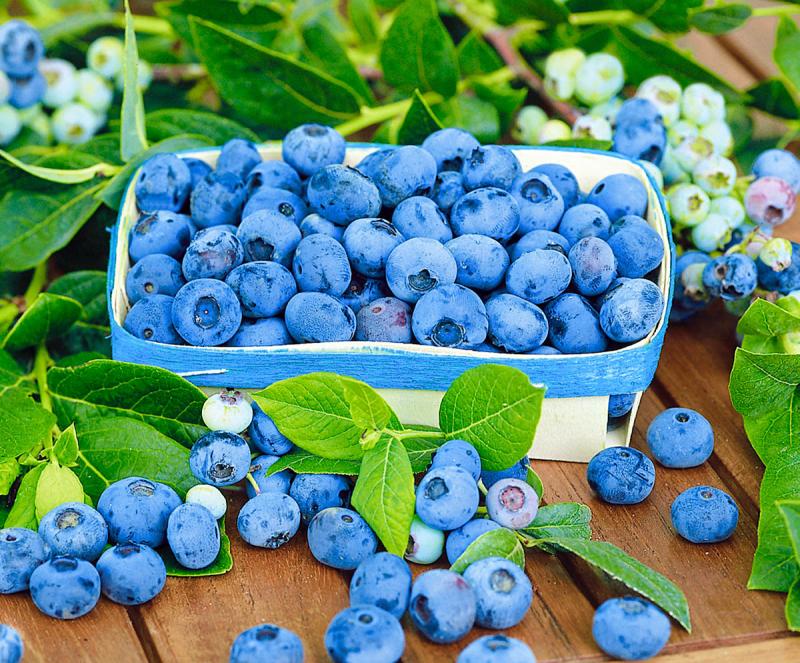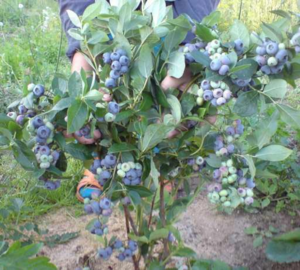The tall blueberry is a mesmerizing sight. Bushes taller than human growth, blue with berries in summer and blazing with all shades of red in autumn cause genuine admiration. On the territory of the countries of the former CIS, such blueberries are no longer considered "foreign", there are many varieties adapted to local conditions.
Content
Variety selection criteria
There are two main types of blueberries in nature:
- marsh. An integral part of coniferous forests. Height - about 1 m. It blooms in May-June, begins to bear fruit in the 11-18th year, the berries ripen in the second half of July-August. The fruits are oblong. The pulp is watery, the taste is slightly sour. The berry mass is on average 0.8 g, one bush gives about 200 g of berries. Bog blueberry is frost-resistant, lives up to 100 years. It is difficult to propagate by seeds, because specific conditions are required: diffused sunlight, high humidity. Seed germination - 45%
- tall (or American). Originally from North America, the berry is extremely popular there, and blueberry pie has become almost a national symbol. The height of a bush of the American species can exceed 3 m (in our conditions, up to 2 m), the diameter of the berry is from 10 to 25 mm. Tall blueberries are more thermophilic and less frost-hardy, but in their homeland their yield is fantastic - up to 10 kg per bush. It is thanks to the large yields that high varieties are in demand in every corner of the globe, where natural conditions allow it to be grown.
Blueberries are sometimes called blueberries, but they are two different berries with some similarities in color and shape. The easiest way to tell them apart is to know that blueberries get juice on your hands, but blueberries don't.
When choosing a blueberry variety, you should pay attention to:
- Ripening period. In the open spaces of the former CIS, only early and mid-season varieties will give a full harvest. But thanks to the warming of the climate in the open field, late varieties also ripen by about 30%. Therefore, late-ripening blueberries are more likely destined for the fate of decorative decoration of the site.
- Winter hardiness. Tall varieties are vulnerable to frost compared to marsh blueberries, which can withstand temperatures as low as -42aboutC... Nevertheless, there are varieties (Bluetta, Weymouth, Jersey) that can withstand frosts down to -35.5aboutC. But for the winter, the bushes are additionally mulched with litter or sawdust, they arrange shelters from the stalks of corn, spruce branches, spunbond, spud up with snow so that after the winter thaws the tops of the shoots and buds do not freeze. In the Urals and Siberia, blueberries are bent to the ground and then covered.
- Compactness. A moment of great importance for small areas. It will not work to "squeeze" tall blueberries between trees or plant them closer, violating the planting scheme, because sunlight is vital for it. In the shade, the berries become sour, fewer flower buds are laid, on which the volume of the blueberry harvest next year depends.
I have 6 bushes growing in one line. The first two bushes are in full sun for 2 hours more than the last two. The difference in development is very noticeable. The former gave good growth, and the flower buds are visually larger than those of the latter. I will transplant these extreme sufferers after leaf fall.
Blueberry varieties for different regions
One of the advantages of growing blueberries is that the bush does not grow, but only spreads out a little in breadth due to lateral shoots, but this is controlled by pruning. But, for example, blueberries or blackberries are difficult to keep in place - they quickly spread throughout the territory.
For better pollination, it is recommended to plant several varieties of blueberries and preferably at different ripening times. Many varieties are suitable for growing in all regions of the country, but it is still better to take into account the local climate. For example, for the Urals and Siberia, varieties created on the basis of marsh blueberries are perfect:
- Taiga beauty. The berries are slightly faceted, of pleasant taste, but no aroma; winter hardiness - almost up to -43aboutFROM;
- Shegarskaya. The variety requires a pollinator; the berries are sweet and sour, the skin is thin, the yield is up to 1.5 kg per bush; the variety is disease- and frost-resistant;
- Draper. The berries are similar to blueberries - purple to black, tasty and aromatic; but the vitality limit of the variety is only -20aboutC, therefore hibernates under cover.
Photo gallery: blueberries for the Urals and Siberia
- Blueberry Taiga beauty has slightly faceted berries, pleasant taste
- The Shegarskaya blueberry variety strikes not with its external beauty, but with its exceptional resistance.
- Draper blueberries without shelter can freeze out in a harsh winter
In the middle lane, Belarus, Ukraine and the southern regions of Russia, early varieties are popular:
- Duke - shoots up to 1.8 m long firmly maintain a vertical position, gracefully bending only from the weight of a large number of berries; the yield per bush is 6–8 kg, the size of the berry is 1.7–2 cm, the skin is dense to light crunch, the pulp looks like a delicate sweet marmalade, slightly tart, leaving a wine aftertaste; 42–56 days pass between mass flowering and the beginning of harvest; weakly forms new shoots; the grade is transportable; withstands frosts down to -28aboutC, needs shelter;
- Erliblu - reaches a height of 1.8 m and gives an average of 4–7 kg of berries per bush; the disadvantage is the frequency of fruiting; on the branches, the berries persist for up to a week, but they absolutely do not tolerate transportation; sour taste; fruiting takes place in two passes: the first - from the beginning of July, the second - in the beginning of August;
- Bludzhey - a variety with vertically located shoots; has large berries - up to 4 g, with a pleasant wine flavor;
- Spartan is a variety with a weak shoot-forming ability, the maximum bush height is up to 2.1 m; ripening takes place in waves, with a gradual shrinking of berries; fruits are poorly preserved on the branches; blue berries with an intense waxy bloom, sweet taste with low astringency;
- River - the maximum height of the bush reaches 2 m; from the fourth year, it confidently gives 4-5 kg per bush, the taste of fragrant berries with hints of fruit and blueberries; maturation is uncomfortable; the variety is unpretentious, but requires shelter for the winter.
Photo gallery: early blueberry varieties for the middle lane, Ukraine, Belarus
- Blueberries are even looking strong and juicy
- Spartan blueberries need to be protected because they grow slowly
- Berries of the Reka variety both in appearance and taste resemble blueberries
- Blueberry Duke - the embodiment of all virtues
- Erliblu's name literally means "early blue" or "early blueberry"
The river is, perhaps, the most problem-free variety, under my conditions, due to early fruiting, it always has time to prepare for winter. Not the largest-fruited, but there are other varieties for this.
Most varieties begin to bear fruit confidently in the 4th year, but in the third year, the first signal berries may already appear.
Features of growing tall garden blueberries
There are no differences in the cultivation of any sort or type of blueberry, despite the assurances of some gardeners to the contrary. Soil acidity for any blueberry should be between 3.5 and 4.5 Ph. This is the most important indicator - the guarantee that this crop will grow and bear fruit. Since the acidity of ordinary garden soil is 6–7 Ph, a specific substrate from high peat is used for blueberries (it is more acidic than low peat). For looseness, bark and chips of any tree species that have rotted over 3–4 years are added to it.
For mulch, coniferous litter (spruce and pine needles) is used, which contains particles of mycorrhizal fungi, due to which blueberries exist. Its roots cannot take nutrients from the ground and become helpless without mycorrhiza developing on the tips of blueberry roots. It supplies the bush with the necessary nitrogen, phosphorus, potassium, acids.
Video: planting blueberries
Nitrogen-containing fertilizers - cow dung, bird droppings - are contraindicated in blueberries. From the age of 2, mineral fertilizers are used, intended for plants of the heather family, which include blueberries - Azofosku, Fertiku-universal, etc.
When watering blueberries, they observe the golden mean, avoiding waterlogging or drying out the earthy coma. Excessive moisture levels displace oxygen, which leads to soil acidification. Microorganisms die, blueberry roots rot. If watering is not enough, then the harvest will be adequate - poor. Blueberries are watered often, but little by little, evenly from all sides.
To determine if watering is needed, take a handful of soil under the mulch and squeeze it in a fist. If water is dripping, then you need to wait a pause.
Blueberry leaves strongly evaporate moisture, that is, the pores (stomata) on the leaf do not close in hot weather, so in the heat the bushes are watered 2-3 times a day, especially during the fruiting period. Fine or fine spray irrigation is recognized as the best irrigation technique. Particular attention is paid to the quality of the water - it should not be alkaline. You can acidify the water with a special tool or with the help of improvised means:
- high-moor peat - based on a bucket of water, take 100 g for infusion in rainwater and 150 g for tap water; insist 2-3 days, stirring occasionally;
- vinegar 9% concentration - 200 ml per bucket of water;
- citric acid - 2 tsp. for 3 liters of water.
Pruning
Bushes of tall blueberries need pruning, especially for varieties with a strong shoot-forming ability. In any case, weak, damaged by rodents and diseased shoots are subject to removal. They are easily distinguishable in the mass of branches - abnormally thin, with suspicious spots or burst bark. Incorrectly growing branches are cut out - inside the bush or parallel to the ground, as well as “upstarts” that are knocked out of the crown.
Remove old shoots 6-7 years old, because much less berries are formed on them... The age of the branches is determined by:
- on the bark - in young people it is smooth and rich in color, and starting from the second or third year, the bark begins to lignify; by the age of 6–7, the branches become completely “wooden” and have a dull color;
- on fruit twigs - lateral branches, which appear at 2-3 years of age; old branches are literally studded with short fruit branches.
On a personal plot, few people are chasing record-large berries; it is more important to get a large harvest here. Therefore, when pruning adult bushes, an average of 10 or more fruiting shoots are left... Pruning helps shape the crown of the bush, especially for highly spreading varieties, from which the outer shoots are removed. In upright bushes, branches are cut from the middle, which improves ventilation and lighting of the bush.
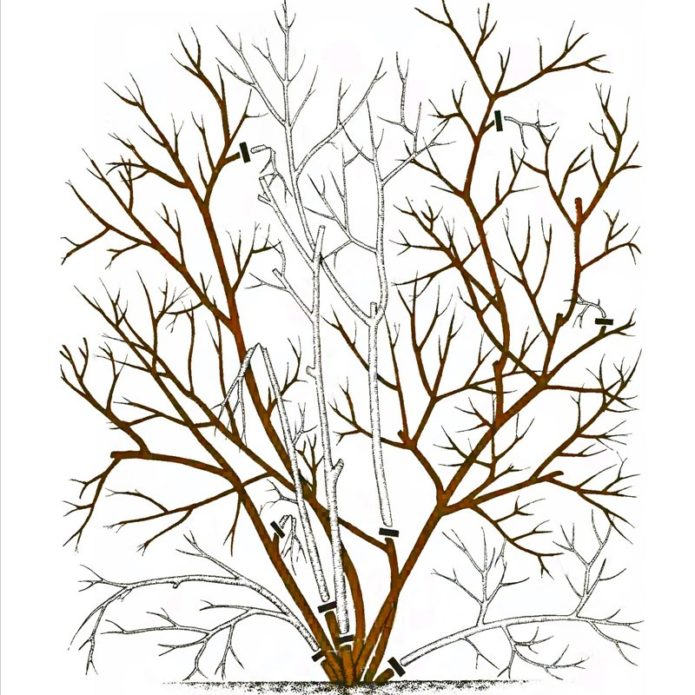
With sanitary pruning, it is necessary to remove branches that lie on the ground, as well as thicken the bush
For tall blueberries, you will have to allocate a place with good lighting, take care of the acidity of the soil. But in comparison with undersized varieties, it gives a huge yield.
